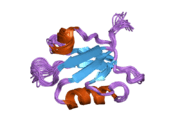MPP1
55 kDa erythrocyte membrane protein is a protein that in humans is encoded by the MPP1 gene.[5][6]
Palmitoylated membrane protein 1 is the prototype of a family of membrane-associated proteins termed MAGUKs (membrane-associated guanylate kinase homologs). MAGUKs interact with the cytoskeleton and regulate cell proliferation, signaling pathways, and intracellular junctions. Palmitoylated membrane protein 1 contains a conserved sequence, called the SH3 (src homology 3) motif, found in several other proteins that associate with the cytoskeleton and are suspected to play important roles in signal transduction.[6]
References
- 1 2 3 GRCh38: Ensembl release 89: ENSG00000130830 - Ensembl, May 2017
- 1 2 3 GRCm38: Ensembl release 89: ENSMUSG00000031402 - Ensembl, May 2017
- ↑ "Human PubMed Reference:".
- ↑ "Mouse PubMed Reference:".
- ↑ Ruff P, Speicher DW, Husain-Chishti A (Sep 1991). "Molecular identification of a major palmitoylated erythrocyte membrane protein containing the src homology 3 motif". Proc Natl Acad Sci U S A. 88 (15): 6595–9. doi:10.1073/pnas.88.15.6595. PMC 52133. PMID 1713685.
- 1 2 "Entrez Gene: MPP1 membrane protein, palmitoylated 1, 55kDa".
Further reading
- Metzenberg AB, Gitschier J (1993). "The gene encoding the palmitoylated erythrocyte membrane protein, p55, originates at the CpG island 3' to the factor VIII gene". Hum. Mol. Genet. 1 (2): 97–101. doi:10.1093/hmg/1.2.97. PMID 1301163.
- Bryant PJ, Woods DF (1992). "A major palmitoylated membrane protein of human erythrocytes shows homology to yeast guanylate kinase and to the product of a Drosophila tumor suppressor gene". Cell. 68 (4): 621–2. doi:10.1016/0092-8674(92)90136-Z. PMID 1310897.
- Marfatia SM, Leu RA, Branton D, Chishti AH (1995). "Identification of the protein 4.1 binding interface on glycophorin C and p55, a homologue of the Drosophila discs-large tumor suppressor protein". J. Biol. Chem. 270 (2): 715–9. doi:10.1074/jbc.270.2.715. PMID 7822301.
- Maruyama K, Sugano S (1994). "Oligo-capping: a simple method to replace the cap structure of eukaryotic mRNAs with oligoribonucleotides". Gene. 138 (1–2): 171–4. doi:10.1016/0378-1119(94)90802-8. PMID 8125298.
- Kim AC, Metzenberg AB, Sahr KE, et al. (1997). "Complete genomic organization of the human erythroid p55 gene (MPP1), a membrane-associated guanylate kinase homologue". Genomics. 31 (2): 223–9. doi:10.1006/geno.1996.0035. PMID 8824805.
- Marfatia SM, Morais-Cabral JH, Kim AC, et al. (1997). "The PDZ domain of human erythrocyte p55 mediates its binding to the cytoplasmic carboxyl terminus of glycophorin C. Analysis of the binding interface by in vitro mutagenesis". J. Biol. Chem. 272 (39): 24191–7. doi:10.1074/jbc.272.39.24191. PMID 9305870.
- Suzuki Y, Yoshitomo-Nakagawa K, Maruyama K, et al. (1997). "Construction and characterization of a full length-enriched and a 5'-end-enriched cDNA library". Gene. 200 (1–2): 149–56. doi:10.1016/S0378-1119(97)00411-3. PMID 9373149.
- Simpson JC, Wellenreuther R, Poustka A, et al. (2001). "Systematic subcellular localization of novel proteins identified by large-scale cDNA sequencing". EMBO Rep. 1 (3): 287–92. doi:10.1093/embo-reports/kvd058. PMC 1083732. PMID 11256614.
- Strausberg RL, Feingold EA, Grouse LH, et al. (2003). "Generation and initial analysis of more than 15,000 full-length human and mouse cDNA sequences". Proc. Natl. Acad. Sci. U.S.A. 99 (26): 16899–903. doi:10.1073/pnas.242603899. PMC 139241. PMID 12477932.
- Ota T, Suzuki Y, Nishikawa T, et al. (2004). "Complete sequencing and characterization of 21,243 full-length human cDNAs". Nat. Genet. 36 (1): 40–5. doi:10.1038/ng1285. PMID 14702039.
- Gerhard DS, Wagner L, Feingold EA, et al. (2004). "The Status, Quality, and Expansion of the NIH Full-Length cDNA Project: The Mammalian Gene Collection (MGC)". Genome Res. 14 (10B): 2121–7. doi:10.1101/gr.2596504. PMC 528928. PMID 15489334.
- Stelzl U, Worm U, Lalowski M, et al. (2005). "A human protein-protein interaction network: a resource for annotating the proteome". Cell. 122 (6): 957–68. doi:10.1016/j.cell.2005.08.029. PMID 16169070.
- Rual JF, Venkatesan K, Hao T, et al. (2005). "Towards a proteome-scale map of the human protein-protein interaction network". Nature. 437 (7062): 1173–8. doi:10.1038/nature04209. PMID 16189514.
- Kusunoki H, Kohno T (2006). "Solution structure of human erythroid p55 PDZ domain". Proteins. 64 (3): 804–7. doi:10.1002/prot.21028. PMID 16741958.
- Gosens I, van Wijk E, Kersten FF, et al. (2007). "MPP1 links the Usher protein network and the Crumbs protein complex in the retina". Hum. Mol. Genet. 16 (16): 1993–2003. doi:10.1093/hmg/ddm147. PMID 17584769.
This article is issued from
Wikipedia.
The text is licensed under Creative Commons - Attribution - Sharealike.
Additional terms may apply for the media files.






